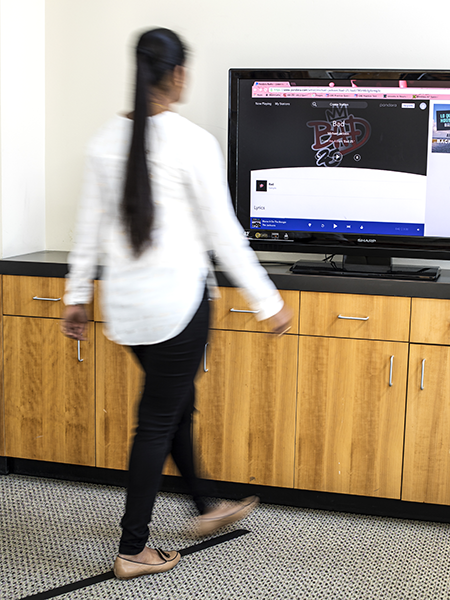Researchers from the Allen School’s Networks & Mobile Systems Lab and Security and Privacy Research Lab teamed up on a new project, CovertBand, to demonstrate how smart devices can be converted into surveillance tools capable of secretly tracking the body movements and activities of users and their companions. CovertBand turns off-the-shelf devices into active sonar systems with the help of acoustic pulses concealed in music. The team’s findings reveal how increasingly popular smart home assistants and other connected devices could be used to compromise users’ privacy in their own homes — even from half a world away.
“Most of today’s smart devices including smart TVs, Google Home, Amazon Echo and smartphones come with built-in microphones and speaker systems — which lets us use them to play music, record video and audio tracks, have phone conversations or participate in videoconferencing,” Allen School Ph.D. student and co-lead author Rajalakshmi Nandakumar told UW News. “But that also means that these devices have the basic components in place to make them vulnerable to attack.”
As fellow author and Ph.D. student Alex Takakuwa points out, “Other surveillance approaches require specialized hardware. CovertBand shows for the first time that through-barrier surveillance is possible using no hardware beyond what smart devices already have.”
CovertBand relies on repetitive acoustic pulses in the range of 18 to 20 kHz. While that is typically low enough that most adults are unlikely to pick up on the signals, young people and pets might — and an audible volume is required for more distant surveillance or to pick up activity through walls. To get around this, the team found that they could disguise the pulses under a layer of music, with repetitive, percussive beats the most effective at hiding the additional sound.

Left to right: Tadayoshi Kohno, Rajalakshmi Nandakumar, and Shyam Gollakota (Not pictured: Alex Takakuwa)
“To our knowledge, this is the first time anyone has demonstrated that it is possible to convert smart commodity devices into active sonar systems using music,” said Allen School professor and co-author Shyam Gollakota.
By connecting a smartphone to a portable speaker or flat-screen TV, the researchers discovered they could use the data collected through CovertBand to accurately identify repetitive movements such as walking, jumping, and exercising up to a distance of six meters within line of sight, and up to three meters through walls. Having proven the concept, researchers believe a combination of more data and the use of machine learning tools would enable rapid classification of a greater variety of movements — and perhaps enable the identification of the individual making them.
With CovertBand, Allen School researchers have identified a plausible threat, given the increasing ubiquity of these devices in our pockets and in our living rooms. But our embrace of emerging technologies needn’t end on a sour note. As professor and co-author Tadayoshi Kohno points out, when it comes to cybersecurity, knowledge is power.
“We’re providing education about what is possible and what capabilities the general public might not know about, so that people can be aware and can build defenses against this,” he said.
The researchers will present a paper detailing their findings at the Ubicomp 2017 conference in Maui, Hawaii next month.
Read the full UW News release here. Learn more and listen to samples of the CovertBand attack music on the project web page here. Check out articles on CovertBand in Fast Company, Digital Trends, New Atlas, and The Register.


